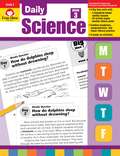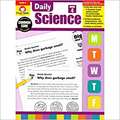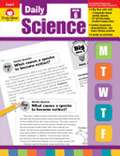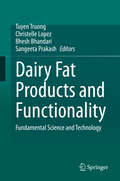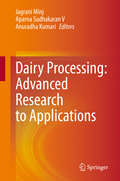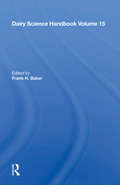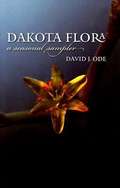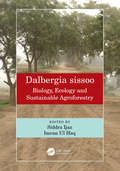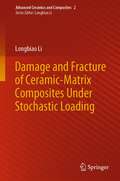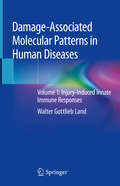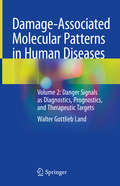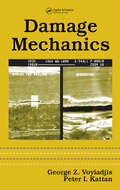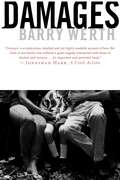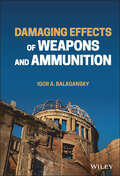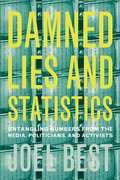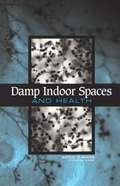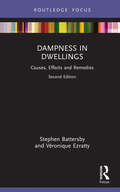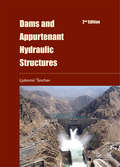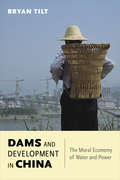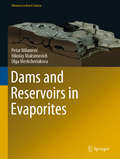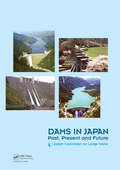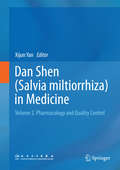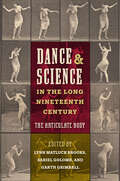- Table View
- List View
Daily Science (Daily Science Series #Grade 3)
by Evan-MoorFit standards-based science instruction into your curriculum! Help your grade 3 students develop a genuine understanding of standards-based scientific concepts and vocabulary using the 150 engaging activities in Daily Science! A variety of rich resources, including vocabulary practice, hands-on science activities, and comprehension tests in multiple-choice format, help you successfully introduce students to earth, life, and physical science concepts. <P><P> 30 weeks of instruction cover the following standards-based science topics: <P><P> Big Idea 1: Living things have adaptations that help them survive in their environment. <br> Week 1: Why do flowers have different colors and scents? <br>Week 2: How do dolphins sleep without drowning? <br>Week 3: Why does a cactus have needles? <br>Week 4: Why do birds migrate? <br>Week 5: Unit Review <P><P>Big Idea 2: Plants have many parts. Each part does a special job. <br>Week 1: What's the difference between a fruit and a vegetable? <br>Week 2: How does a tree get water from its roots to its leaves? <br>Week 3: Why do dandelions turn white and fluffy? <br>Week 4: Why do leaves change color in the fall? <br>Week 5: Unit Review <P><P>Big Idea 3: Fossils tell us about the plants and animals that lived long ago. <br>Week 1: Where is the best place to look for fossils? <br>Week 2: How do scientists know how old a fossil is? <br>Week 3: Why are fossils of ocean animals found on mountains today? <br>Week 4: How does something become a fossil? <br>Week 5: Unit Review <P><P>Big Idea 4: Air is a gas that surrounds us, takes up space, and creates weather. <br>Week 1: Why can't you breathe in outer space? <br>Week 2: Why does a can of soda sometimes explode when you open it? <br>Week 3: Where does wind come from? <br>Week 4: How do birds fly? <br>Week 5: Unit Review <P><P>Big Idea 5: Light moves in a straight line until it hits an object. Light can be absorbed, refracted, or reflected. <br>Week 1: Why does it get hot in the car on a sunny day when it is cold outside? <br>Week 2: Why does a straw look bent in a glass of water? <br>Week 3: Why do things look backward in a mirror? <br>Week 4: How does a movie projector work? <br>Week 5: Unit Review <P><P>Big Idea 6: Electricity travels in currents. It can pull and push the things around it. <br>Week 1: Where does lightning come from? <br>Week 2: Why do people get a shock when they touch metal? <br>Week 3: How does a battery make electricity? <br>Week 4: How does flipping a switch make a light bulb light up? <br>Week 5: Unit Review
Daily Science Grade 4 Practice Book
by Barbara PriceHelp your grade 4 students develop a genuine understanding of standards-based scientific concepts and vocabulary using the 150 engaging activities in Daily Science! A variety of rich resources, including vocabulary practice, hands-on science activities, and comprehension tests in multiple choice format, help you successfully introduce students to earth, life, and physical science concepts.
Daily Science Grade 6+ (Daily Science)
by Evan-Moor Educational PublishersHelp your grade 6 students explore standards-based science concepts and vocabulary using 150 daily lessons! A variety of rich resources including vocabulary practice, hands-on science activities, and comprehension tests in multiple-choice format help you successfully introduce students to earth, life, and physical science concepts. 30 weeks of instruction covers many standards-based science topics.
Dairy Fat Products and Functionality: Fundamental Science and Technology (Springerbriefs In Food, Health, And Nutrition Ser.)
by Tuyen Truong Christelle Lopez Bhesh Bhandari Sangeeta PrakashThis work highlights a new research area driven by a material science approach to dairy fats and dairy fat-rich products where innovative dairy products and ingredients can be tailor-made. Cutting edge topics such as tribology of dairy fats and dairy products, manipulation of differentiated-sized milk fat globules, milk fat interesterification for infant formula, structuring of lipids in dairy products and production of human milk fat substitutes by including dairy fats are featured in dedicated chapters authored by international scientific experts from across the globe. The text also presents in-depth research on proteomic characterization, digestion and the nutritional functionality of milk fat globule membrane. The biosynthesis, chemistry, digestion and nutritional roles of milk lipids, physics of dairy fats, structure and functionality of the milk fat globule membrane, analytical methods, materials science, technology and manufacturing of dairy fat-rich products such as butter, dairy fat spreads, dairy creams, cream powders and ghee are also covered in-depth.Dairy Fat Products and Functionality: Fundamental Science and Technology is a useful reference text for technologists and scientists interested in advancing their fundamental knowledge of dairy fat and dairy products as well as using a materials science and technology approach to guide efforts or widen research opportunities in optimizing the functionality of these products. From their physics and chemistry to their nutritional values and methodologies, this comprehensive and innovative text covers all the necessary information needed to understand the new methods and technologies driving the modern production of milk fat products.
Dairy Processing: Advanced Research to Applications
by Jagrani Minj Aparna Sudhakaran V Anuradha KumariThis book focuses on advanced research and technologies in dairy processing, one of the most important branches of the food industry. It addresses various topics, ranging from the basics of dairy technology to the opportunities and challenges in the industry. Following an introduction to dairy processing, the book takes readers through various aspects of dairy engineering, such as dairy-based peptides, novel milk products and bio-fortification. It also describes the essential role of microorganisms in the industry and ways to detect them, as well as the use of prebiotics, and food safety. Lastly, the book examines the challenges faced, especially in terms of maintaining quality across the supply chain. Covering all significant areas of dairy science and processing, this interesting and informative book is a valuable resource for post-graduate students, research scholars and industry experts.
Dairy Science Handbook: Vol. 15
by Frank H. BakerThis handbook represents advanced technology in a problem-oriented form readily accessible to livestock producers, operators of family farms, managers of agribusinesses, and students of animal agriculture. It includes papers on farm and ranch business management and economics, and animal management.
Dakota Flora: A Seasonal Sampler
by David J. OdeOde (botanist/ecologist, South Dakota Department of Game, Fish and Parks) collects revised, reprinted columns entitled "Dakota Flora" that he wrote for the South Dakota Conservation Digest from 1987 to 2005. The short odes to individual plants (e.g., buffalo currant, Dakota buckwheat, and Black Hills spruce) are organized by season. The book includes color photos, a listing of the scientific names of the plants mentioned, and an annotated list of plant field guides. Annotation ©2007 Book News, Inc., Portland, OR (booknews.com)
Dalbergia sissoo: Biology, Ecology and Sustainable Agroforestry
by Siddra IjazDalbergia sissoo (Shisham) is a perennial tree species native to the Asian subcontinent. It is an economically significant tree for its value in forestry, agroforestry, and horticulture. The high-quality timber imparts this tree species a significant commercial value. Besides valuable timber, it also exhibits medicinal, industrial, and agroforestry allied attributes. This tree has been introducing to the geographical regions where it does not exist naturally, which indicates its significant properties, getting diverse communities' attention. This book provides information about this tree species based on the latest research trends and development on the subject. It addresses researchers, forestry specialists, natural resource managers, or all those interested in the rehabilitation, maintenance, and management of Dalbergia sissoo tree resources. Key features Discusses botanical features, reproductive characters, taxonomy, geographical distribution, and ecological importance of Dalbergia sissoo. Highlights physiological and biochemical features of Dalbergia sissoo and vis-à-vis contribution to the sustainability of the ecosystem. Explains ethnobotany of Dalbergia sissoo, its ethnobotanical uses to cure various ailments, and contribution to the pharmaceutical industry. Provides a comprehensive account of insect pest threat and diseases as a leading cause of deteriorating growth, cultivation, productivity, and quality losses in Dalbergia sissoo. Describes conventional breeding methods and non-conventional strategies for genetic improvement, biodiversity, and conservation of D. sissoo Relays sustainability, socio-economic importance, agroforestry trends, current scenario, and future challenges of D. sisso
Damage and Fracture of Ceramic-Matrix Composites Under Stochastic Loading (Advanced Ceramics and Composites #2)
by Longbiao LiThis book presents the relationships between tensile damage and fracture, fatigue hysteresis loops, stress-rupture, fatigue life and fatigue limit stress, and stochastic loading stress. Ceramic-matrix composites (CMCs) possess low material density (i.e., only 1/4 - 1/3 of high-temperature alloy) and high-temperature resistance, which can reduce cooling air and improve structure efficiency. Understanding the failure mechanisms and internal damage evolution represents an important step to ensure reliability and safety of CMCs. This book investigates damage and fracture of fiber-reinforced ceramic-matrix composites (CMCs) subjected to stochastic loading, including: (1) tensile damage and fracture of fiber-reinforced CMCs subjected to stochastic loading; (2) fatigue hysteresis loops of fiber-reinforced CMCs subjected to stochastic loading; (3) stress rupture of fiber-reinforced CMCs with stochastic loading at intermediate temperature; (4) fatigue life prediction of fiber-reinforced CMCs subjected to stochastic overloading stress at elevated temperature; and (5) fatigue limit stress prediction of fiber-reinforced CMCs with stochastic loading. This book helps the material scientists and engineering designers to understand and master the damage and fracture of ceramic-matrix composites under stochastic loading.
Damage-Associated Molecular Patterns in Human Diseases: Volume 1: Injury-Induced Innate Immune Responses
by Walter Gottlieb LandThis book presents current understanding of the importance of modern immunology in the etiopathogenesis of human diseases and explores how this understanding is impacting on diagnosis, prognosis, treatment, and prophylaxis. As the core of modern immunology, the “danger/injury model” is introduced and addressed throughout the book. Volume I of the book describes the network of damage-associated molecular pattern molecules (DAMPs) and examines the central role of DAMPs in cellular stress responses and associated regulated cell death, the promotion and resolution of inflammation, the activation of innate lymphoid cells and unconventional T cells, the stimulation of adaptive immunity, and tissue repair. The significance of DAMPs in a wide range of human diseases will then be explored in Volume II of the book, with discussion of the implications of injury-induced innate immunity for present and future treatments. This book is written for professionals from all medical and paramedical disciplines who are interested in the introduction of innovative data from immunity and inflammation research into clinical practice. The readership will include practitioners and clinicians such as hematologists, rheumatologists, traumatologists, oncologists, intensive care anesthetists, endocrinologists such as diabetologists, psychiatrists, neurologists, pharmacists, and transplantologists.
Damage-Associated Molecular Patterns in Human Diseases: Volume 2: Danger Signals as Diagnostics, Prognostics, and Therapeutic Targets
by Walter Gottlieb LandThis book is a continuance of the topic: “DAMPs in Human Diseases”, the basics of which were described in a first volume by the same author. This second volume presents our current understanding of the impact of sterile stress/injury-induced innate immune responses on the etiopathogenesis of human diseases by focusing on those diseases that are pathogenetically dominated by DAMPs, i.e., on polytrauma, various solid organ injuries (brain, lung, kidney, liver), atherosclerosis, and cerebro-cardiovascular diseases. Our growing understanding of the pathogenetic function of activating DAMPs and suppressive DAMPs (“SAMPs”) is used as a point of departure to explore how these molecules can be used as biomarkers to extend and improve current diagnostic and prognostic modalities. Moreover, this new knowledge about the pathogenetic function of DAMPs and SAMPs is taken as a sound and plausible reason for discussing their implications for present and future treatment of the diseases addressed here. In this context, the focus is on the potential of DAMPs as future therapeutic targets and SAMPs as future therapeutics, applied in strict compliance with safety precautions, as also recommended in this work. The book is intended for professionals from all medical and paramedical disciplines who are interested in applying innovative data from inflammation and immunity research to clinical practice. The readership will include practitioners and clinicians working in the broad field of acute and chronic inflammatory/fibrotic diseases, in particular, traumatologists and intensivists; neurologists and neurosurgeons; cardiologists and cardiac surgeons; pulmonologists and thoracic surgeons; vascular surgeons; nephrologists; gastroenterologists and hepatologists; and pharmacists. Also available: Damage-Associated Molecular Patterns in Human Diseases - Vol. 1: Injury-Induced Innate Immune Responses
Damage Mechanics
by George Z. Voyiadjis Peter I. KattanBefore a structure or component can be completed, before any analytical model can be constructed, and even before the design can be formulated, you must have a fundamental understanding of damage behavior in order to produce a safe and effective design. Damage Mechanics presents the underlying principles of continuum damage mechanics along with the
Damages
by Barry WerthDamages is the riveting true story of one family’s legal struggles in the world of medicine. At the urging of a friend, the Sabias filed a medical malpractice lawsuit against Dr. Humes and Norwalk Hospital. Barry Werth takes us through the seven-year lawsuit, allowing us to see the legal strategy plotted by the Sabias’s attorneys, Connecticut’s premier medical malpractice law firm.
Damaging Effects of Weapons and Ammunition
by Igor A. BalaganskyComprehensive coverage of weapon damage effects on a variety of objects Damaging Effects of Weapons and Ammunition delivers a thorough exploration of a range of issues related to the effects of ammunition and weapons. The book includes coverage of the basic concepts of the theory of efficiency and the physical foundations of the functional and damaging effects of fragments, shaped charges, high-explosive and penetrating weapons. The author discusses the calculation formulas used to evaluation the parameters of damage fields and their interaction with various objects. Additionally, the book expands on the damage criteria of weapons, the characteristics of the vulnerability of objects with respect to a variety of damaging factors, dependencies for assessing safe distances, and the resistance of various structures to the effects of explosion and impact. Damaging Effects of Weapons and Ammunition also offers: Detailed calculation methods indicating areas of application and the necessary units of used quantities Extensive examples of classic designs of ammunition from around the world Discussions of the characterization of various types of ammunition, including high-explosive, fragment, penetrative, and shaped charges A chapter on the numerical simulation of high-speed processes Perfect for technical specialists working in the fields of explosion safety and explosives, Damaging Effects of Weapons and Ammunition also belongs in the libraries of researchers and students studying explosion phenomena, explosive technologies, explosion safety, and materials science.
Damned Lies and Statistics: Untangling Numbers from the Media, Politicians and Activists
by Joel BestWhile startling statistics shape the thinking about social issues, the author attests that these numbers can be wrong. This book is a lively guide to spotting bad statistics and learning to think critically about these influential numbers.
Damp Indoor Spaces and Health
by Institute of Medicine of the National AcademiesAlmost all homes, apartments, and commercial buildings will experience leaks, flooding, or other forms of excessive indoor dampness at some point. Not only is excessive dampness a health problem by itself, it also contributes to several other potentially problematic types of situations. Molds and other microbial agents favor damp indoor environments, and excess moisture may initiate the release of chemical emissions from damaged building materials and furnishings. This new book from the Institute of Medicine examines the health impact of exposures resulting from damp indoor environments and offers recommendations for public health interventions. Damp Indoor Spaces and Health covers a broad range of topics. The book not only examines the relationship between damp or moldy indoor environments and adverse health outcomes but also discusses how and where buildings get wet, how dampness influences microbial growth and chemical emissions, ways to prevent and remediate dampness, and elements of a public health response to the issues. A comprehensive literature review finds sufficient evidence of an association between damp indoor environments and some upper respiratory tract symptoms, coughing, wheezing, and asthma symptoms in sensitized persons. This important book will be of interest to a wide-ranging audience of science, health, engineering, and building professionals, government officials, and members of the public.
Dampness in Dwellings: Causes, Effects and Remedies (Routledge Focus on Environmental Health)
by Stephen Battersby Véronique EzrattyThis revised and updated book provides a definition of dampness in each of its forms; it details the various potential sources and causes that can result in damage to the building and damage to the health of the occupiers. It is both practical and provides an outline of the possible solutions, looking at aspects of building design and construction that can reduce or avoid the risk of dampness. It also discusses why dampness is a risk to the health of occupiers and so justifies the need to protect health by reducing or removing it.This book: Provides a valuable resource for housing, legal, and medical professionals Discusses possible solutions in aspects of building design and construction that can reduce or avoid the risk of dampness and also the safe removal of mould Provides an explanation of the legal framework in the UK and potential legal remedies for adverse health effects as a result of dampness The new edition of Dampness in Dwellings includes expanded details on the health implications of dampness in the home, legal updates, and new thinking in the wake of the tragic death of Awaab Ishak. It provides a pivotal resource for active professionals in housing, medical, and legal sectors.
Dams and Appurtenant Hydraulic Structures, 2nd edition
by Ljubomir TanchevDams and Appurtenant Hydraulic Structures, now in its second edition, provides a comprehensive and complete overview of all kinds of dams and appurtenant hydraulic structures throughout the world.The reader is guided through different aspects of dams and appurtenant hydraulic structures in 35 chapters, which are subdivided in five themes:I. Dams an
Dams and Development in China: The Moral Economy of Water and Power (Contemporary Asia in the World)
by Bryan TiltChina is home to half of the world's large dams and adds dozens more each year. The benefits are considerable: dams deliver hydropower, provide reliable irrigation water, protect people and farmland against flooding, and produce hydroelectricity in a nation with a seeimingly insatiable appetite for energy. As hydropower responds to a larger share of energy demand, dams may also help to reduce the consumption of fossil fuels, welcome news in a country where air and water pollution have become dire and greenhouse gas emissions are the highest in the world. Yet the advantages of dams come at a high cost for river ecosystems and for the social and economic well-being of local people, who face displacement and farmland loss. This book examines the array of water-management decisions faced by Chinese leaders and their consequences for local communities. Focusing on the southwestern province of Yunnan—a major hub for hydropower development in China—which encompasses one of the world's most biodiverse temperate ecosystems and one of China's most ethnically and culturally rich regions, Bryan Tilt takes the reader from the halls of decision-making power in Beijing to Yunnan's rural villages. In the process, he examines the contrasting values of government agencies, hydropower corporations, NGOs, and local communities and explores how these values are linked to longstanding cultural norms about what is right, proper, and just. He also considers the various strategies these groups use to influence water-resource policy, including advocacy, petitioning, and public protest. Drawing on a decade of research, he offers his insights on whether the world's most populous nation will adopt greater transparency, increased scientific collaboration, and broader public participation as it continues to grow economically.
Dams and Reservoirs in Evaporites (Advances in Karst Science)
by Petar Milanović Nikolay Maksimovich Olga MeshcheriakovaThis book shares essential insights on evaporites and their effects on dams and reservoirs. The intensity of the solution and suffusion process in evaporites (gypsum and salt) is much greater than the solution of carbonates, and evaporites are particularly vulnerable at dam and reservoir sites.Moreover, the presence of evaporites in the vicinity of dams or reservoirs often leads to serious problems: numerous dams in countries around the world (e.g. China, Germany, Iran, Iraq, Peru, Russia, Spain, the Unites States, and Venezuela) have been affected by evaporite dissolution problems. Several of these dams were seriously endangered or ultimately abandoned, even though the best available engineering prevention and remediation practices were applied. Conventional geotechnical methods based on treating the underground (e.g. grout curtains) or surface (e.g. protective blankets) were not successful.This book presents and analyzes revealing case studies in this regard. To improve geotechnical remediation in connection with preventing seepage from reservoirs situated in evaporites, particularly in gypsum, it puts forward a new chemical solution that, after painstaking laboratory testing, was successfully applied in the field.
Dams in Japan: Past, Present and Future
by Japan Commission on Large DamsOverview of Japan’s long water history, by the Japanese Commission on large dams. Starting from the 7th century, when irrigation ponds were first constructed for paddy cropping, until the beginning of the 21st century. Elaborates on various roles of dams: water supply, power generation and flood control. Moreover, tries to clarify the negative impacts of dams on the natural environment and local societies, as well as extensive efforts made to minimize these impacts. Includes appendices with location and characteristics of main dams, administrative organs, river management system and water resources development river systems and facilities to offer the full picture. Richly-illustrated. Intended for dam and water resources professionals.
Damselflies of Texas
by John C. AbbottOn any warm summer day, you can easily observe damselflies around a vegetated pond or the rocks along the banks of a stream. Like the more familiar dragonfly, damselflies are among the most remarkably distinctive insects in their appearance and biology, and they have become one of the most popular creatures sought by avocational naturalists. Damselflies of Texas is the first field guide dedicated specifically to the species found in Texas. It covers 77 of the 138 species of damselflies known in North America, making it a very useful guide for the entire United States. Each species account includes:- illustrations of as many forms (male, female, juvenile, mature, and color morphs) as possible- common and scientific names, with pronunciation- distribution map- key features- identifying characteristics- discussion of similar species- status in Texas- habitat, seasonality, and general commentsIn addition to photographing damselflies in the wild, the author and illustrator have developed a new process for illustrating each species by scanning preserved specimens and digitally painting them. The resulting illustrations show detail that is not visible in photographs. The book also contains chapters on damselfly anatomy, life history, conservation, names, and photography, as well as a list of species that may eventually be discovered in Texas, state and global conservation rankings, seasonality of all species in chronological order, and additional resources and publications on the identification of damselflies.
Dan Beard, Scoutmaster of America
by Wyatt BlassingameDan Beard was happiest when he was out-of-doors. As a boy, he spent much time hiking, fishing, and rafting. He became a map maker so that he could work outside. He started the Sons of Daniel Boone so that boys could learn to love nature. Then, his group merged with several other groups to become Boy Scouts of America.
Dan Shen (Salvia miltiorrhiza) in Medicine: Volume 2. Pharmacology and Quality Control
by Xijun YanThis book reviews research on Dan Shen, compiles data from clinical trials and biological experiments, and summarizes the latest research advances. It covers the medicinal herb, herbal pieces, and new proprietary drugs that contain it; it also covers simple and compound, traditional and contemporary formulas, and addresses a broad range of subjects, including: standardized cultivation; biodiversity; effective substances and their biological activities; quality control; and clinical trials. The book goes on to present the clinical trials on Dantonic, especially focusing on its therapeutic effects for coronary heart disease. It discusses compound prescriptions and compatibilities, from the herbal piece level to composition level, and describes approaches to research on modern Chinese medicine. Volume 1 describes the biology and chemistry of Dan Shen, while Volume 2 focuses on pharmacology and quality control. Volume 3 describes the clinical research on Dan Shen. Editor Xijun Yan is the President of Tianjin Tasly Group and a Member of the TCM Standardization Technical Committee. Gathering contributions from more than 100 authors working in the field of pharmaceutical and clinical research, the book presents and analyzes the available information from multiple aspects, reflects the current status of Dan Shen research, and offers an essential reference work for further research and development.
Dance and Science in the Long Nineteenth Century: The Articulate Body
by Lynn Matluck Brooks Sariel Golomb Garth GrimballRevealing the interplay and influence of dance and science during an age of colonial expansion Bringing together dance and science, two paradigms that explore the nature and possibilities of the body, this volume illuminates the meanings and articulations of dance in nineteenth-century societies. This global collection of studies reveals how the two fields informed each other’s development and engaged with dominant European worldviews in a time of unprecedented colonial expansion. The chapters in Dance and Science in the Long Nineteenth Century examine how trends and developments in the performing arts reflected scientific thinking of this era, including the categorization of “types” of bodies and the ranking of cultural and religious beliefs, as well as how dance served as an active site of inquiry where the workings and limits of the human body could be studied. Researchers discuss topics including the influence of plant biology on the aesthetics of ballet, technological advancements in the staging and recording of performances, arguments for the use of Eurhythmics in promoting a stronger “race,” and European fascination with Indian dance and yoga. Featuring response essays that put leading scholars in conversation with one another and offer new perspectives, this volume is unique in its geographic scope and its discussion of diverse bodies, cultures, themes, and scientific disciplines. It sheds light on a historical interplay that has shaped many of today’s political and cultural realities.Contributors: Johanna Pitetti-Heil | Chantal Frankenbach | Jane Desmond | Christian Ducomb | Claudia Jeschke | Kélina Gotman | Pallabi Chakravorty | Andrea Harris | Dick McCaw | Stephen Ha | Emily Coates | Tiziana Leucci | Elizabeth Claire | Susan Cook | Carrie Streeter | Olivia Sabee | Janice Ross | Alexander H. Schwan | Whitney Laemmli
